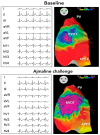Epicardial Ablation for Arrhythmogenic Disorders in Patients with Brugada Syndrome
- PMID: 39857610
- PMCID: PMC11762830
- DOI: 10.3390/biomedicines13010027
Epicardial Ablation for Arrhythmogenic Disorders in Patients with Brugada Syndrome
Abstract
Brugada syndrome (BrS) is an inherited arrhythmogenic disorder characterized by distinct electrocardiographic patterns and an increased risk of sudden cardiac death due to ventricular arrhythmias. Effective management of BrS is essential, particularly for high-risk patients with recurrent arrhythmias. While implantable cardioverter-defibrillator (ICD) is effective in terminating life-threatening arrhythmias, it does not prevent arrhythmia onset and can lead to complications such as inappropriate shocks. Epicardial ablation has emerged as a promising treatment option for patients with recurrent ventricular arrhythmias and frequent ICD interventions. This review examines the latest advancements in the management of Brugada syndrome, focusing on the role and rationale of epicardial ablation for the treatment of patients at risk of sudden cardiac death.
Keywords: Brugada syndrome; epicardial ablation; sudden cardiac death.
Conflict of interest statement
The authors declare no conflicts of interest.
Figures


References
-
- Pappone C., Ciconte G., Manguso F., Vicedomini G., Mecarocci V., Conti M., Giannelli L., Pozzi P., Borrelli V., Menicanti L., et al. Assessing the Malignant Ventricular Arrhythmic Substrate in Patients with Brugada Syndrome. J. Am. Coll. Cardiol. 2018;71:1631–1646. doi: 10.1016/j.jacc.2018.02.022. - DOI - PubMed
Publication types
LinkOut - more resources
Full Text Sources

